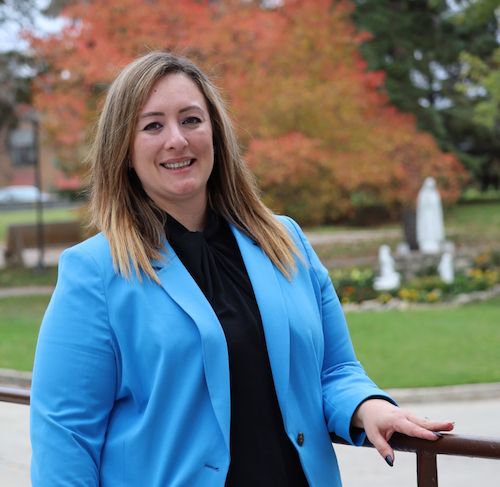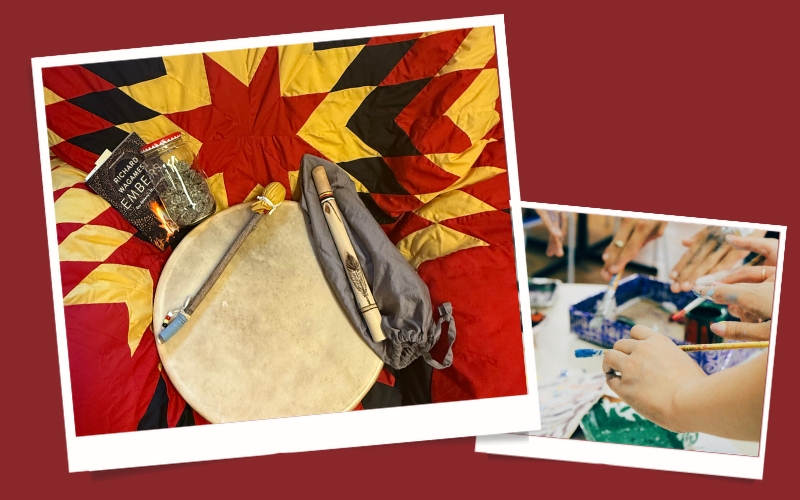What started as a chance encounter at a national conference has led to a meaningful initiative at St.Amant called Spiritual Exploration Through Art. This 8-week pilot project encourages art therapy through an Indigenous lens, bringing together culture, creativity and agency for those living with developmental disabilities.
“Our spiritual health practitioner, Andrew Terhoch, met Dr. Kendra Rieger, who is trying to create an Arts for Equity Network in Canada*,” explains Lindsay McCombe, Manager of St.Amant Research Centre. “Andrew had been mulling over similar ideas and Dr. Rieger was looking to partner with health and social services organizations. We saw an opportunity to work together, and of course, since she’s in academia, there had to be a research component, which we were really excited about.”

McCombe, who has been working at St.Amant for over a decade, was immediately on board. “I have experienced the healing power of art in my personal life, and I never thought that my research world and my art world would combine,” she shares. “More than that, this is a national research initiative, and we get to bring the voices of people with disabilities to the table. There’s a myth out in the world that research for people with disabilities is too hard. We’re working hard to dispel that.”
Spiritual Exploration Through Art was launched with the support of Indigenous knowledge keepers such as Val Vint, a Métis artist, whose wisdom and guidance were crucial to the project. “Our elder Val says that art is medicine,” continues McCombe. “We are doing our best to respond to Call to Action 22, and to let the folks we support lead these processes as much as we can. This means we slow down, and we’re so intentional about the art we’re creating.”
Call to Action 22 from the Truth and Reconciliation report states, “We call upon those who can effect change within the Canadian health-care system to recognize the value of Aboriginal healing practices and use them in the treatment of Aboriginal patients in collaboration with Aboriginal healers and Elders where requested by Aboriginal patients.”
McCombe says that the desires of those supported by St.Amant, as well as their abilities, shaped the pilot, and often in important ways. “We had an artist who had come to participate but then was hesitating and decided she didn’t want to get involved anymore,” she remembers. “But Val is a drum carrier, and when she brought her drum…that woman took a turn and played with such intention. We started bringing more instruments to encourage her, and we’ve added a welcoming song to our time together. It means a lot to everyone now.”
When it comes to the research component, McCombe is clear on what she hopes it will show. “I want to expand our viewpoint on what accessible art is, and how it can help,” she explains. “We’re in a unique position to do that, and we are very much looking forward to bringing the voice of disability to art therapy research and having a true seat at the table.”
Most importantly, the pilot project is already having an impact on how people with disabilities are supported at St.Amant. “There’s a participant who is always scratching at a medically irritated part of her body,” McCombe explains. “Her current care plan has her holding a pillow over that area to help stop the urge to scratch. But when she tried the drum, it was the first time all day that she hadn’t been trying to get to the irritation. Her nurse picked up on it and documented it in her chart as another tool available to her overcome that challenge.”
When art and compassionate care come together, those who receive services benefit holistically. “To have nurses coming by to support, to learn and to add to ways to care for people is really incredible,” McCombe concludes. “It’s not in their job description to help someone through a spiritual art practice, but they’re all in. We can all see the positive impacts it has on people’s moods and lives, and hopefully the research will show that, as well.”
•••
*The Arts for Equity work of Drs. Kendra Rieger, Sheryl Reimer-Kirkham, and Anne Tuppurainen is supported in part by funding from the Social Sciences and Humanities Research Council and the Canadian Institutes of Health Research).

